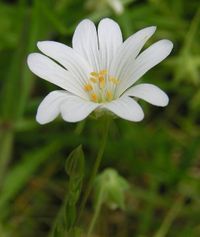Stellaria
| Stellaria subsp. var. | Chickweed, Stitchwort | |||||||||||||||||||||||||||||||||||||||||||||||||||||||
|---|---|---|---|---|---|---|---|---|---|---|---|---|---|---|---|---|---|---|---|---|---|---|---|---|---|---|---|---|---|---|---|---|---|---|---|---|---|---|---|---|---|---|---|---|---|---|---|---|---|---|---|---|---|---|---|---|

|
|
| ||||||||||||||||||||||||||||||||||||||||||||||||||||||
| ||||||||||||||||||||||||||||||||||||||||||||||||||||||||
Stellaria is a genus of about 90-120 species flowering plants in the family Caryophyllaceae, with a cosmopolitan distribution. Common names include stitchwort and chickweed.
| Standard Cyclopedia of Horticulture |
|---|
|
Stellaria (Latin, star, referring to the form of the flower). Caryophyllaceae. Annual or perennial herbs, mostly diffuse, tufted or weakly ascending, glabrous or pubescent, of little cultural value. Leaves opposite, simple: fls. usually white, in terminal or axillary, naked or leafy paniculate cymes or rarely subsolitary; sepals 5, very rarely 4; petals just as many as the sepals, 2-cleft or rarely laciniate or only emarginate; stamens 10 or fewer by abortion; ovary 1-celled: caps. globose, ovoid or oblong, dehiscent by as many or twice as many teeth as there are carpels.— About 100 species, scattered all over the world but chiefly in the temperate regions. CH
|
Cultivation
Propagation
Pests and diseases
Species
Selected species:
Gallery
-
photo 1
-
photo 2
-
photo 3
References
External links
- w:Stellaria. Some of the material on this page may be from Wikipedia, under the Creative Commons license.
- Stellaria QR Code (Size 50, 100, 200, 500)
